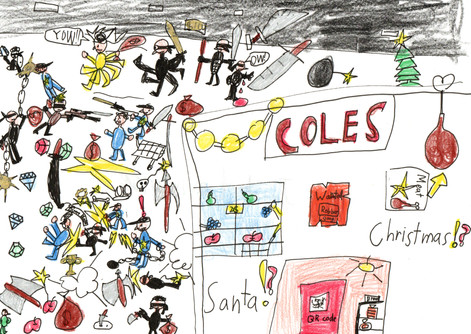The Creative Glow-Up: How Nurturing, Not Teaching, Helps Kids Flourish in Art
- Faye Z

- Apr 4, 2022
- 4 min read
Updated: Feb 4
One of the most common questions I get from parents is, "What course do you offer? Do you teach watercolour, oil painting, or sketching?"
If I had to name the kind of art course I offer, I’d call it an art nurturing class. It’s not structured around teaching specific skills, or a particular theme—instead, it’s about providing inspiration, and allowing kids to explore their own interests, discover their preferred styles and materials, and develop organically. When they reach a point where they need a skill to bring a specific ideas or effect to life, that’s when it’s introduced—naturally, not as a strict lesson, but as a way to support their creativity.
"The rainbow in the sky got wet, so it dropped colourful raindrops." — Patrick, 4-year-old
Unlike adults, kids don’t separate their mind from what they experience—it's intertwined. A raindrop isn’t just water falling from the sky; it’s a moment of experience, soaked in curiosity and fantasy. They’re constrained by rules or logic— What adults call “imagination” isn’t really imagination to kids. It’s just them boldly and freely expressing how they see the world.Through artistic creation, children connect with their inner world and external world and process experiences. If we get too caught up in perfect lines and flawless technique, we risk losing the very thing that makes art "art".
Kids are born artists—if their creativity hasn’t surfaced, it’s often because the noise around them is drowning it out. In the right environment, it doesn’t take long for them to rediscover that fearless, expressive spark.
In this article, I’ve gathered artworks from some of my students. In just six months, we saw that spark come alive—in their confidence, their creativity, and the unique styles they naturally developed.
Sean is my friend’s 8-year-old son. He joined our online art course in late July 2021 during covid lockdown.
When Sean first joined the class, he wasn’t particularly outstanding compared to other kids. Below are some of his early artwork. His compositions were mostly scattered objects placed side by side without much structure, and his choice of colour was quite limited.
After two rounds of online classes, the biggest change in Sean was that drawing became a natural part of his life. He started to spend more time on drawing than playing games on his device.
After the lockdown ended, Sean’s mom started driving 40 minutes every Saturday to take him to in-person classes in Eastwood. Below are some of his works from last term. Looking back at where he started, it’s amazing to see how much his sense of form, colour, and expression have grown.
Sean takes his art seriously—he knows exactly how he wants to draw and which colours to use. One time, his mom was waiting for him in the classroom. The class is already finished, but Sean was still searching for the perfect colour for one of his ideas. “Just pick any colour, it doesn’t matter.", Sean's mom told him. Sean firmly said no, and continually search until he found the one that is "right" to him. I love how intentional he is with his creative choices—it shows just how much he values what he creates.
Seven-year-old Qiyuan was one of the very first students in our online course. According to his mom, his progress has been "visible to the naked eye."
If you look at his work over time, the changes are clear. In the beginning, his drawings felt a little stiff and cautious, but gradually, he started to loosen up. His compositions became more fluid, his ideas more expansive. Then, as his confidence grew, his approach shifted again—his recent works feel more refined and thoughtful, with a stronger sense of rhythm and composition.
At this age, kids grow and change so quickly, and it’s amazing to see those transformations unfold through their art.
From this point on, his artwork became more fluid and expressive, with richer details and a greater sense of creativity.
The jungle painting marked a turning point in his artistic style. His approach shifted from expansion to refinement, and his work began to show a deeper sense of aesthetic consideration.
Six-year-old Max is fascinated by birds—you’d be hard-pressed to find a single piece of his artwork without them. His creative process is completely spontaneous.
One time, as I was talking to him, he furrowed his brows, waved his little hand at me, and went, “Shhh.” Then, in a calm, almost meditative tone, he said, “I know what I want to draw now.” And just like that, he dove straight into his work.
Max takes his art seriously. In one piece, he accidentally drew more birds than he had planned. When he noticed, he looked slightly disappointed for a moment but quickly made up his mind—he simply painted over the extras. To him, staying true to his original idea was more important than making the painting look conventionally "perfect."
Six-year-old Camilla and her four-year-old sister Olivia create artwork full of charm and childlike wonder. Though they’re sisters, their artistic styles have already started to take their own unique paths.
Camilla’s drawings reflect a young girl’s innocence and careful attention to detail. Most of her artwork revolves around *“my family”*—her compositions are more structured, representational, and often tell a story. Olivia, on the other hand, fully embraces the playful, uninhibited nature of children’s symbolic art. Her work feels spontaneous and free, with lines and colors that seem to dance across the page. There’s a joy in her drawings that’s almost tangible, radiating an energy that immediately pulls you in.
Can you tell which ones were drawn by the older sister and which ones by the younger? 😊
Nurturing creativity takes time—it can’t be rushed. Many art classes follow a structured, step-by-step approach, like pre-made meals—quick, efficient, and easy to replicate. While this helps kids pick up skills, it often leaves little room for true artistic expression.
Creativity flourishes when kids have the freedom to explore and experiment. It’s more like cooking from scratch—slower, less polished at first, but far more nourishing in the long run. In a space that encourages curiosity and self-expression, kids naturally develop their own artistic voice—something that stays with them long after the lessons end.





















































































































































Comments